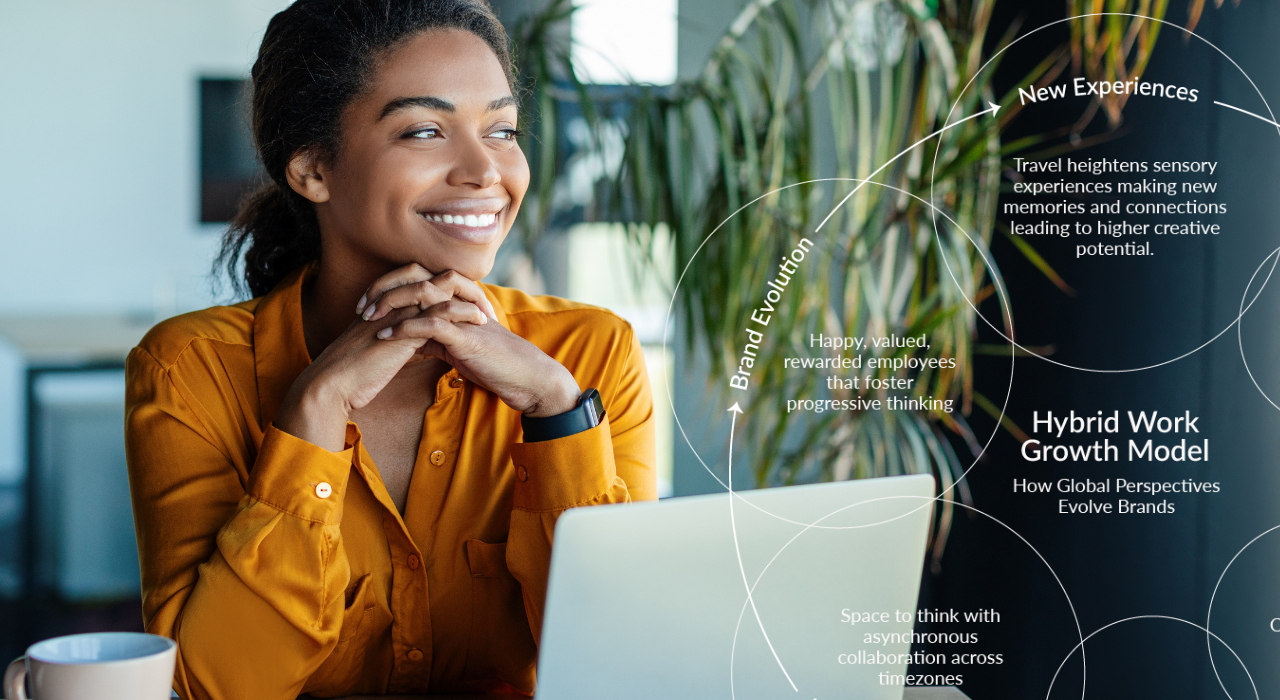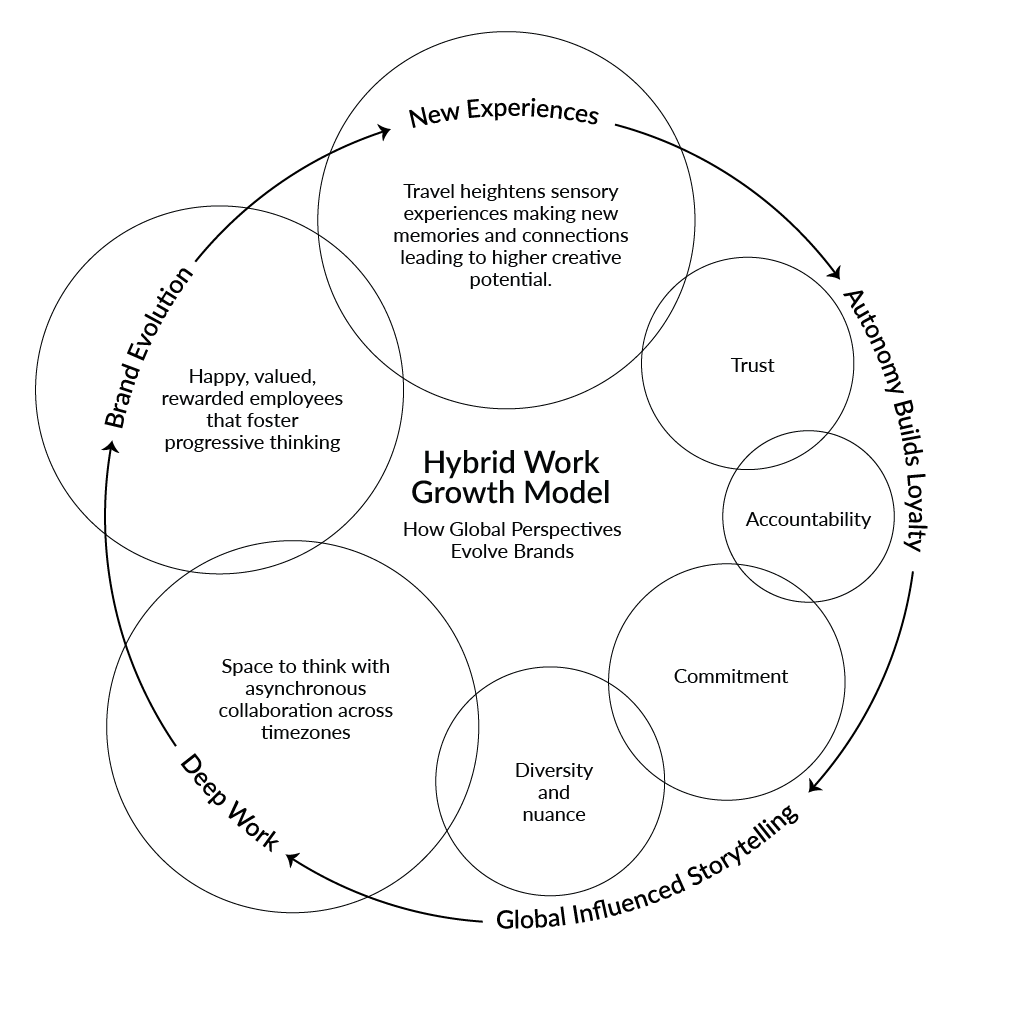Is Global Remote Work Becoming a Brand’s Most Valuable Advantage?
Graphic by: Kelli Binnings, Image Credit: Prostock Studio
For decades, companies believed creativity and collaboration lived inside office walls. But now, the world is more accessible, making global remote and hybrid workers part of just about every team.
This isn’t just an HR philosophy. It’s a brand strategy and it’s reshaping how brands maximize time, attract top talent, and stay relevant in a world that moves faster than ever.
It’s also revealed something bigger, more human, and far more strategic in creating a strong internal brand culture. Turns out, people think better when they’re trusted, supported, and exposed to new environments.
So if you think about it, where your team works shapes how your brand thinks.
The Cognitive Power Behind Global Remote Work
Science has made one thing clear: the creative brain thrives on novelty, autonomy, and the ability to align work with natural energy rhythms and the need for variety. It’s no wonder that while we’re traveling, taking in new sights, meeting new people, creating new memories, your brain is literally rewiring itself with new stories. These new connections are ultimately what fuel and inspire our creative thinking.
Global remote teams gain:
access to global talent, not just local pools
increased creativity from exposure to these new environments
stronger loyalty and retention through autonomy and employee trust
lower operating costs with higher output (round-the-clock business hours)
richer diversity of thought that shapes stronger storytelling and strategy
It’s probably time companies stop treating hybrid work as a compromise and start using it as an engine, because it isn’t a compromise; it’s an advantage. It fuels performance, well-being, and long-term brand growth.
Hybrid Work Isn’t a Trend, It’s a Brand Growth Model
When employees work from a mix of environments, something interesting happens:
Travel, new spaces, and cultural experiences = better ideas.
Novelty triggers dopamine pathways and new associations in the brain. These new associations stack up, connecting memories and generating ideas in a way that only exposure grants you.
Autonomy Builds Loyalty
Trust creates commitment. Commitment creates better work. And better work builds stronger brands over time.
Global Perspectives Shape Stronger Storytelling
A brand built by diverse minds resonates with more people. Consumer psychology thrives on cultural nuance and the ability to bond through shared experiences. Exposure to new ways of thinking makes the nuance more accessible.
Deep Work Actually Happens
Less commuting = more thinking. Fewer meetings = more output. Asynchronous collaboration = more space for idea absorption and strategic thinking.
The Brand Evolves With the Team
When the people building the brand grow, the brand grows with them. By investing in your team’s mental energy, continued education, and desire for trust and flexibility, you, in turn, minimize burnout, increase personal productivity, and foster brand-champion thinking.
How Can Companies Maximize This Advantage?
“Brand culture isn’t lost in hybrid environments; it’s giving you an opportunity to be intentionally curated.”
Use hybrid as a system, not a schedule. Make “home” for deep work and the office for collaboration. Travel for creativity and off-sites for culture building. Each environment triggers a different cognitive state.
Shift KPIs from hours to outcomes. Measure impact, not presence.
Build creative “novelty windows.” Think quarterly work-from-anywhere weeks, maybe organize team retreats and off-sites, or even offer coworking space benefit programs. These micro-experiences build macro-level innovation.
Design rituals to keep culture alive. Coffee roulettes through randomized video chats (love this style btw, try it for yourself with Gatheround), organize monthly creativity hours, or stick to the classics with weekly standups for sharing resources, storytelling, and collaborative needs.
The Long-Term Brand Advantage
Brands built in rigid, repetitive environments eventually start to think rigidly and repetitively.
But brands built by people who are exposed to new places, new ideas, new cultures, new ways of thinking, and new sensory experiences become more adaptable, more resonant, and more future-proof.
Hybrid and global remote work aren’t perks. They’re central to what makes progressive, forward-thinking brands so attractive; they support creative infrastructure.
They’re strategic tools for building brands that evolve rather than maintain the status quo. And they’re one of the most undervalued competitive advantages of this decade.
The brands that embrace and encourage hybrid work environments will be the ones that still matter 10 years from now.
If you’re interested in learning more, send me an email! I’d love to chat and hear your thoughts about the article.
And if you’re looking for more ways you can drive influence and impact through your brand, download this quick read of an ebook, “Transforming Brand Perception: 7 Actions to Change the Way People See Your Brand.”


